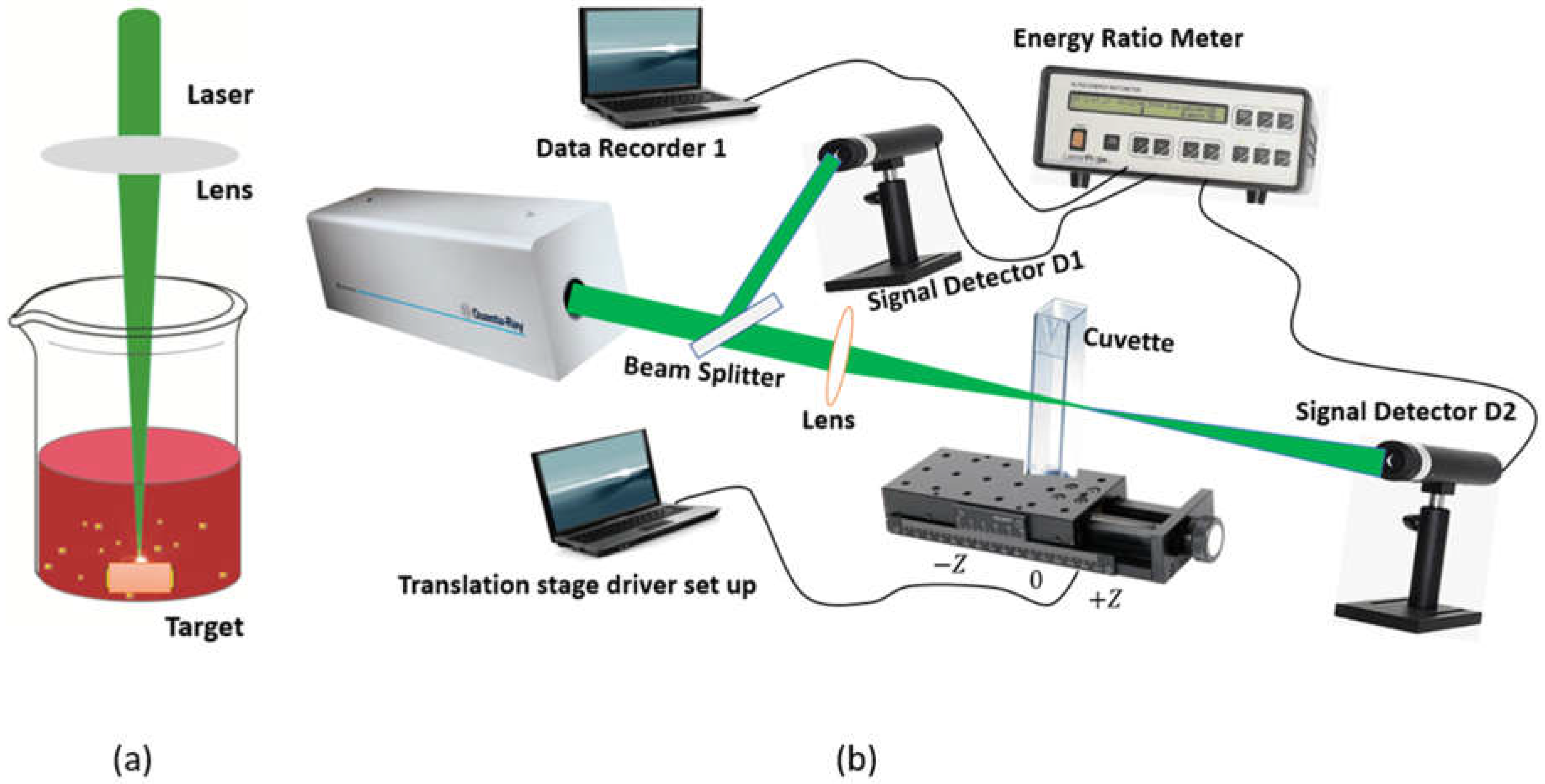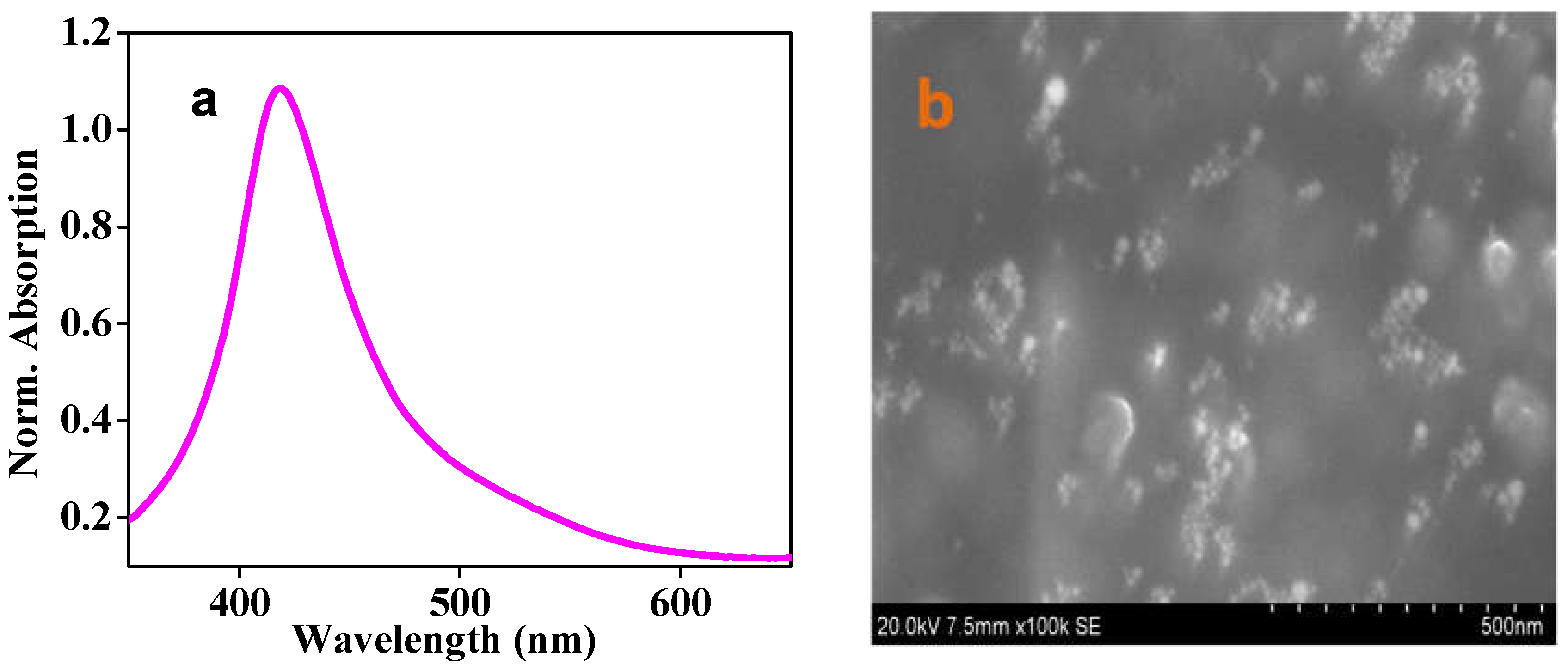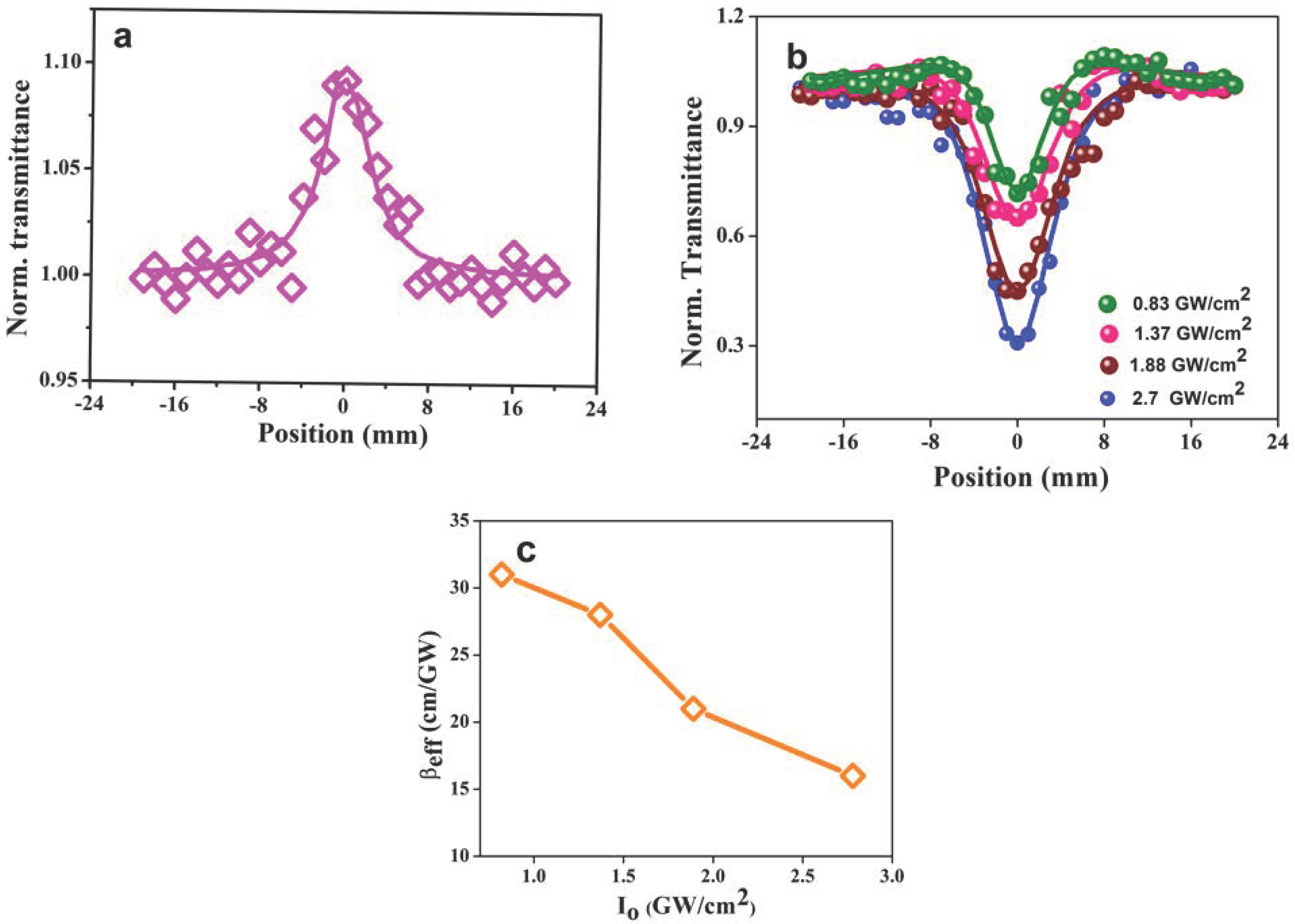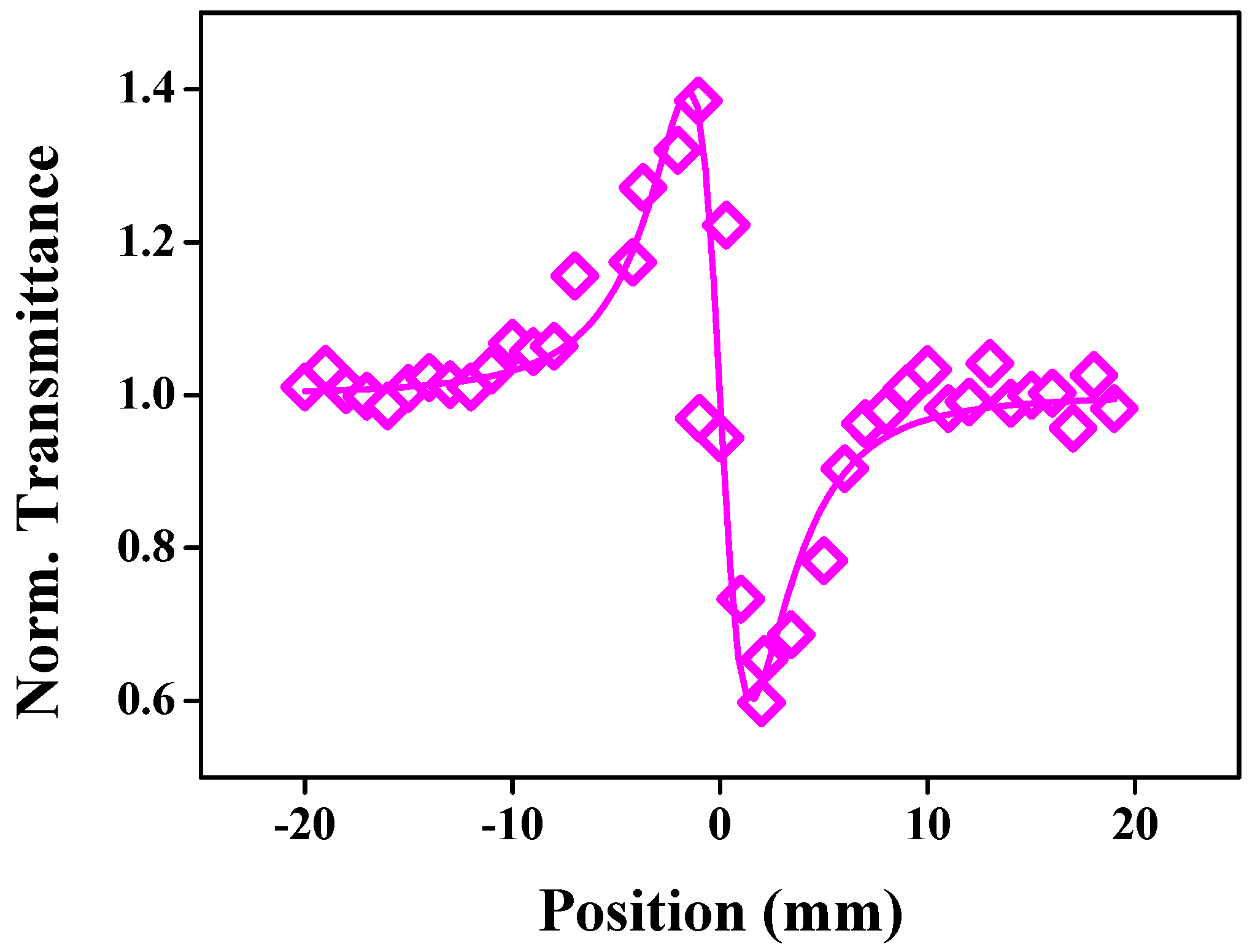Silver Nanoparticles under Nanosecond Pulsed Laser Excitation as an Intensity Sensitive Saturable Absorption to Reverse Saturable Absorption Switching Material
Abstract
:1. Introduction
2. Experimental Method
3. Results and Discussion
4. Conclusions
Author Contributions
Funding
Data Availability Statement
Acknowledgments
Conflicts of Interest
References
- Papagiannouli, I.; Aloukos, P.; Rioux, D.; Meunier, M.; Couris, S. Effect of the Composition on the Nonlinear Optical Response of Aux Ag1–x Nano-Alloys. J. Phys. Chem. C 2015, 119, 6861–6872. [Google Scholar] [CrossRef]
- Link, S.; El-Sayed, M.A. Shape and Size Dependence of Radiative, Non-radiative and Photothermal Properties of Gold Nanocrystals. Int. Rev. Phys. Chem. 2000, 19, 409–453. [Google Scholar] [CrossRef]
- Lee, K.S.; El-Sayed, M.A. Gold and Silver Nanoparticles in Sensing and Imaging: Sensitivity of Plasmon Response to Size, Shape and Metal Composition. J. Phys. Chem. B 2006, 110, 19220–19225. [Google Scholar] [CrossRef] [PubMed]
- Edappadikkunnummal, S.; Nherakkayyil, S.N.; Kuttippurath, V.; Chalil, D.M.; Desai, N.; Keloth, C. Surface Plasmon Assisted Enhancement in the Nonlinear Optical Properties of Phenothiazine by Gold Nanoparticle. J. Phys. Chem. C 2017, 121, 26976–26986. [Google Scholar] [CrossRef]
- Wang, Q.Q.; Han, J.B.; Gong, H.M. Linear and nonlinear optical properties of Ag nanowire polarizing glass. Adv. Func. Mat. 2006, 16, 2405–2408. [Google Scholar] [CrossRef]
- Zhang, Y.X.; Wang, Y.H. Nonlinear optical properties of metal nanoparticles: A review. RSC Adv. 2017, 7, 45129–45144. [Google Scholar] [CrossRef] [Green Version]
- Shijua, E.; Abhijith, T.B.; Narayana Rao, D.; Chandrasekharan, K. Phenomenal Nonlinear Optical Behavior from Gold and Silver through Au@Ag Core- Shell Nanostructures. J. Mol. Liq. 2021, 333, 115935. [Google Scholar]
- Boltaev, G.S.; Ganeev, R.A.; Krishnendu, P.; Maurya, S.K.; Redkin, P.V.; Rao, K.S.; Zhang, K.; Guo, C. Strong third-order optical nonlinearities of Ag nanoparticles synthesized by laser ablation of bulk silver in water and air. Appl. Phys. A 2018, 124, 766. [Google Scholar] [CrossRef]
- Pinçon, N.; Palpant, B.; Prot, D.; Charron, E.; Debrus, S. Third-order nonlinear optical response of Au:SiO2 thin films: Influence of gold nanoparticle concentration and morphologic parameters. Eur. Phys. J. D 2002, 19, 395–402. [Google Scholar] [CrossRef]
- Sridharan, K.; Kuriakose, T.; Philip, R.; Parkv, T.J. Transition metal (Fe, Co and Ni) oxide nanoparticles grafted graphitic carbon nitrides as efficient optical limiters and recyclable photocatalysts. Appl. Surf. Sci. 2014, 308, 19–147. [Google Scholar] [CrossRef]
- Shiju, E.; Bharat, M.; Narendran, N.K.S.; Rao, D.N.; Chandrasekharan, K. Optical diode activity in an axially asymmetric nonlinear medium incorporated with phenothiazine and silver nanoparticles. Opt. Mater. 2020, 99, 109557–109562. [Google Scholar] [CrossRef]
- Shiju, E.; Narendran, N.K.S.; Rao, D.N.; Chandrasekharan, K. A phenothiazine–silver hybrid system exhibiting switching and photo-induced enhancement in nonlinear optical absorption. New J. Chem. 2019, 43, 7962–7971. [Google Scholar]
- Unnikrishnan, K.P.; Nampoori, V.P.N.; Ramakrishnan, V.; Umadevi, M.; Vallabhan, C.P.G. Nonlinear optical absorption in silver nanosol. J. Phys. D. Appl. Phys. 2003, 36, 1242–124513. [Google Scholar] [CrossRef] [Green Version]
- Remya, T.M.; Shiju, E.; Shandev, P.P.; Chandrasekharan, K.; Suja Haridas Unnikrishnanan, P.A. Enhanced Nonlinear Absorption and Efficient Optical Limiting Action of a Few 1,3,4-Oxadiazole Based Donor-Acceptor Systems. J. Mat. Sci. 2021, 56, 3035–3048. [Google Scholar] [CrossRef]
- Shiju, E.; Siji Narendran, N.K.; Narayana Rao, D.; Chandrasekharan, K. Enhanced nonlinear absorption and efficient power limiting action of Au/Ag@ graphite core-shell nanostructure synthesized by laser ablation. Nano Express 2020, 1, 030026. [Google Scholar]
- Semaltianos, N. Nanoparticles by Laser Ablation. Crit. Rev. Solid State Mater. Sci. 2010, 35, 105–124. [Google Scholar] [CrossRef]
- Sreeramulu, V.; Haldar, K.K.; Patra, A.; Rao, D.N. Nonlinear Optical Switching and Enhanced Nonlinear Optical Response of Au−CdSe Heteronanostructures. J. Phys. Chem. C 2014, 118, 303333. [Google Scholar] [CrossRef]
- Jayabalan, J.; Singh AChari, R.; Oak, S.M. Ultrafast third-order nonlinearity of silver nanospheres and nanodiscs. Nanotechnology 2007, 1831, 315704. [Google Scholar] [CrossRef]
- Hari, M.; Mathew, S.; Nithyaja, B.; Joseph, S.A.; Nampoori VP, N.; Radhakrishnan, P. Saturable and reverse saturable absorption in aqueous silver nanoparticles at off-resonantwavelength. Opt. Quantum Electron. 2012, 43, 49–58. [Google Scholar] [CrossRef]
- Ajami, A.; Husinsky, W.; Svecova, B.; Vytykacova, S.; Nekvindova, P. Saturable absorption of silver nanoparticles in glass for femtosecond laser pulses at 400 nm. J. Non-Cryst. Solids 2015, 426, 159–163. [Google Scholar] [CrossRef]
- Edappadikkunnummal, S.; Prasannan, D.; Francis, J.; Desai, N.R.; Keloth, C. An insight into phenomenal optical non-linearities arising from synergistic relationship between selected BODIPYs and noble metal nanoparticles. Appl. Organomet. Chem. 2021, 35, e6029. [Google Scholar] [CrossRef]
- Philip, R.; Chantharasupawong, P.; Qian, H.; Jin, R.; Thomas, J. Evolution of nonlinear optical properties: From gold atomic clusters to plasmonic nanocrystals. Nano Lett. 2012, 12, 4661–4667. [Google Scholar] [CrossRef]
- Aikens, C.; Li, M.; Schatz, G.C. From discrete electronic states to plasmons: TDDFT optical absorption properties of Agn (n = 10, 20, 35, 56, 84, 120) tetrahedral clusters. J. Phys. Chem. C 2008, 112, 11272–11279. [Google Scholar] [CrossRef]
- Parvathy, N.; Jiya, J.; Nithin, J.; Sivakumaran, V.; Reji, P.; Rodolphe, A.; Sabu, T.; Nandakumar, K. Fabrication of Silver-Decorated Graphene Oxide Nanohybrids via Pulsed Laser Ablation with Excellent Antimicrobial and Optical Limiting Performance. Nanomaterials 2021, 11, 880. [Google Scholar]
- Jijuan, J.; Jun, W.; Tong, W.; Yachen, G. Nonlinear Absorption and Ultrafast Dynamics of Ag Nanoparticle. Photonics 2021, 8, 233. [Google Scholar]
- Anand, B.; Addo, S.; Muthukumar Sai, V.; Siva Sankara Sai, S.; Philip, R.; Mitra, S. Improved Optical Limiting in Dispersible Carbon Nanotubes and Their Metal Oxide Hybrids. Carbon 2011, 49, 4767–4773. [Google Scholar] [CrossRef]
- Sudheesh, P.; Siji Narendran, N.K.; Chandrasekharan, K. Third-Order Nonlinear Optical Responses in Derivatives of Phenylhydrazone by Z-Scan and Optical Limiting Studies-Influence of Noble Metal Nanoparticles. Opt. Mater. 2013, 36, 304–309. [Google Scholar] [CrossRef]
- Udayabhaskar, R.; Karthikeyan, B.; Sreekanth, P.; Philip, R. Enhanced Multi-Phonon Raman Scattering and Nonlinear Optical Power Limiting in ZnO:Au Nanostructures. RSC Adv. 2015, 5, 13590–13597. [Google Scholar] [CrossRef]
- Parida, M.R.; Vijayan, C.; Rout, C.S.; Suchand Sandeep, C.S.; Philip, R. Enhanced Optical Nonlinearity in β-AgVO3 Nanobelts on Decoration with Ag Nanoparticles. Appl. Phys. Lett. 2012, 100, 1–6. [Google Scholar] [CrossRef]
- Jayakrishnan, K.; Joseph, K.A.; Bhattathiripad, J.; Ramesan, M.T.; Siji Narendran, N.K.; Chandrasekharan, K. Reverse Saturable Absorption Studies in Polymerized Indole—Effect of Polymerization in the Phenomenal Enhancement of Third Order Optical Nonlinearity. Opt. Mater. 2016, 54, 252–261. [Google Scholar] [CrossRef]
- Kuladeep, R.; Jyothi, L.; Prakash, P.; Mayank Shekhar, S.; Durga Prasad, M.; Narayana Rao, D. Investigation of optical limiting properties of Aluminium nanoparticles prepared by pulsed laser ablation in different carrier media. J. Appl. Phys. 2013, 114, 243101. [Google Scholar] [CrossRef]
- Corrêa, N.F.; Santos, C.E.; Valadão, D.R.; de Oliveira, L.F.; Dupont, J.; Alencar, M.A.; Hickmann, J.M. Third-order nonlinear optical responses of colloidal Ag nanoparticles dispersed in BMI.BF4 ionic liquid. Opt. Mater. Expr. 2016, 6, 1. [Google Scholar] [CrossRef]







Publisher’s Note: MDPI stays neutral with regard to jurisdictional claims in published maps and institutional affiliations. |
© 2021 by the authors. Licensee MDPI, Basel, Switzerland. This article is an open access article distributed under the terms and conditions of the Creative Commons Attribution (CC BY) license (https://creativecommons.org/licenses/by/4.0/).
Share and Cite
Shiju, E.; Sharafudeen, K.; Remya, T.M.; Siji Narendran, N.K.; Sudheesh, P.; Sadasivan Nair, V. Silver Nanoparticles under Nanosecond Pulsed Laser Excitation as an Intensity Sensitive Saturable Absorption to Reverse Saturable Absorption Switching Material. Photonics 2021, 8, 413. https://doi.org/10.3390/photonics8100413
Shiju E, Sharafudeen K, Remya TM, Siji Narendran NK, Sudheesh P, Sadasivan Nair V. Silver Nanoparticles under Nanosecond Pulsed Laser Excitation as an Intensity Sensitive Saturable Absorption to Reverse Saturable Absorption Switching Material. Photonics. 2021; 8(10):413. https://doi.org/10.3390/photonics8100413
Chicago/Turabian StyleShiju, Edappadikkunnummal, Kaniyarakkal Sharafudeen, T. M. Remya, N. K. Siji Narendran, Palengara Sudheesh, and Vijayakumar Sadasivan Nair. 2021. "Silver Nanoparticles under Nanosecond Pulsed Laser Excitation as an Intensity Sensitive Saturable Absorption to Reverse Saturable Absorption Switching Material" Photonics 8, no. 10: 413. https://doi.org/10.3390/photonics8100413
APA StyleShiju, E., Sharafudeen, K., Remya, T. M., Siji Narendran, N. K., Sudheesh, P., & Sadasivan Nair, V. (2021). Silver Nanoparticles under Nanosecond Pulsed Laser Excitation as an Intensity Sensitive Saturable Absorption to Reverse Saturable Absorption Switching Material. Photonics, 8(10), 413. https://doi.org/10.3390/photonics8100413




